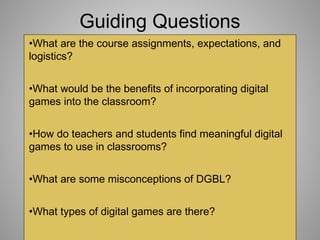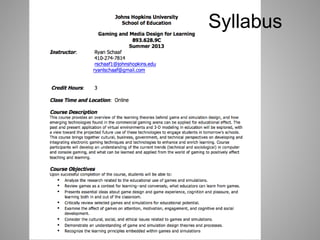Class1 dgbl ineducationjhu_summer2013
- 2. Gaming and Media Design for Learning 893.628.9C Summer Session 5/14/2013 ŌĆō 6/18/2013 Ryan Schaaf Assistant Professor of Technology, Notre Dame in Maryland University Graduate Faculty, Johns Hopkins University SOE
- 3. Guiding Questions ŌĆóWhat are the course assignments, expectations, and logistics? ŌĆóWhat would be the benefits of incorporating digital games into the classroom? ŌĆóHow do teachers and students find meaningful digital games to use in classrooms? ŌĆóWhat are some misconceptions of DGBL? ŌĆóWhat types of digital games are there?
- 4. Syllabus
- 6. BloomŌĆÖs Digital Taxonomy Game Proposal, Game Trailer, Storyboard, PowerPoint Game, Lesson Seed Game Diary, Peer Review Discussion Board Posts, Readings, Modules Discussion Board Posts, Readings, Modules Discussion Board Posts, Readings, Modules Game Diary
- 7. Temporary Course Website http://sites.google.com/site/jhugamingandmediadesign/home Home Page contains Weekly assignments, directions, useful links, and Navigation menu to supporting pages.
- 8. Course Walkthrough & Learner Profile Survey ŌĆó Learner Profile Survey http://bit.ly/2013JHUGaming1 ŌĆó I want to hold off on the Course Walkthrough until the ELC becomes available. For now, I will try to instruct you with directions on what to do on the temporary site.
- 9. What is Digital Game-Based Learning? ŌĆó Digital game-based learning (DGBL) is an instructional method that incorporates educational content or learning principles into video games with the goal of engaging learners. Applications of digital game-based learning draw upon the constructivist theory of education. http://www.learnnc.org/lp/pages/4970
- 10. Warm-Up ŌĆó How many of you have played Angry Birds?
- 12. The Attraction of DGBL ŌĆó mirrors how humans think and how the mind works ŌĆó popularity ŌĆó motivating and fun ŌĆó 21st century learners prefer 21st century methods of learning ŌĆó independence ŌĆó game design utilizes multiple intelligences ŌĆó versatile platform for learning ŌĆó collateral learning in a media rich society ŌĆó safe alternative to reality ŌĆó collaboration and problem-solving
- 13. Gaming and the Mind ŌĆ£Computer-based games provide simulations that often mirror cognitive functions in the brain. Humans think and learn through experiences they have had and via simulations they run in their heads based on those experiences, much as if they were playing video games in their headŌĆØ (Gee 2007). Computer-based games present information in a manner more consistent with how the human brain learns
- 14. Gaming and the Mind Pleasure and Motivation ŌĆópeople enjoy learning new information ŌĆóhard work and deep fun ŌĆ£Good video games give people pleasure. These pleasures are connected to control, agency, and meaningfulness. Good games are problem-solving spaces that create deep learning.ŌĆØ (Gee 2007)
- 15. Gaming in Education Misconceptions
- 17. Finding Paydirt in the Internet Sea Caution: Use careful and deliberate search terms to narrow your search to valid result hits. Billions of available browser-based digital games.
- 18. Activity Select a general concept and perform a Google or other web engine search. Find a digital game that fits your concept and play it. While you are playing the game: What does the game teach? What is the objective of the game? What are the pros and cons of the game?
- 19. Incorporating Digital Game-Based Learning into Instruction Motivation Instructional strategy Closure Assessment Review, Reteach
- 20. Interactive Game Examples http://www.bravekidgames.com/flash_game_home_compost.php Compost 4 Fun
- 21. Magic Pen 2 ŌĆó http://www.physicsgames.net/game/Ma gic_Pen_2.html
- 28. App Wars
- 32. Oregon Settler What can this game teach students? How might you incorporate it into instruction?
- 33. Online Discussion #1 Searching for Digital Games to incorporate into your Curriculum During our session, you learned several strategies for finding browser-based digital games to incorporate into instruction. In this discussion board, identify three to five games you previewed with web links included. How was the game play? Will the game be useful for instruction? How will you utilize it in a lesson?
- 34. Bibliography Armstrong, T. (2003). YouŌĆÖre Smarter than You Think: A KidŌĆÖs Guide to Multiple Intelligences. Minneapolis, MN: Free Spirit Publishing Inc. Campbell, L. & Campbell, B. (1999) Multiple Intelligences and Student Achievement: Success Stories from Six Schools. Alexandria, VA: ASCD Demski, J. (2009). The WoW factor. T.H.E. Journal, 36(10), 30-35. Gee, J.P. (2007). Good video games + good learning: Collected essays on video games, learning, and literacy. New York, NY: Peter Lang. Harris, K. (1986) Self-Motivating of Attentional Behavior Versus Self-Monitoring of Productivity: Effects on On-Task Behavior and Academic Response Rate Among Learning Disabled Children. College Park, MD, Journal of Applied Behavior Analysis Johnson, L., Levine, A., Smith, R., and Smythe, T. (2009). The 2009 Horizon Report: K-12 Edition. Austin, Texas: The New Media Consortium Prensky, M (2001). Digital Game-Based Learning. St. Paul, Minnesota: Paragon House. Shaffer, D.W. (2006). How computer games help children learn. New York, NY: Palgrave Macmillian Skurzynski, G. (1991) Almost the Real Thing. New York, NY: Maxwell MacMillan International
Editor's Notes
- #11: Early in 2012, Angry Birds had the distinction of being downloaded over 1 billion times. The executive vice president of Rovio, Andrew Stalbow provided astonishing usage figures. "In any given day, we have 20-30 million people playing our games connected. And in any given month we have up to 200 million people playing our games." (Dredge, 2012)
- #12: Take the original Angry Birds, which has been used to teach physics. Developer Rovio subsequently worked with NASA on the micro-gravity used in Angry Birds Space to improve its educational value (if you can ignore the exploding pigs in vacuum). That collaboration reached a new orbit with the landing of the Mars Curiosity rover and the release the same month of an Angry Birds Space: Red Planet update with explicit links to NASA educational content about Mars. NewtonŌĆÖs Laws Numeration Data Experimentation trial and error strategic planning, Parabola Trajectory cause and effect the scientific method, goal commitment
- #29: Combined 1.4 million apps
- #32: http://video-game-consoles-review.toptenreviews.com/
- #33: YouŌĆÖve conquered the trail, now itŌĆÖs time to tame the frontier! Experience the next step in The Oregon Trail story, where you and your family can finally settle down and build a new home in the Wild WestŌĆ” The Oregon Trail: American Settler is a fun and addictive game stocked with heaps of engaging features to keep you entertained for hours and hours! Build the largest and greatest town the Wild West has ever seen! FEATURES: Ō£ö Create and manage your own frontier town Ō£ö Relive memorable moments from The Oregon Trail! Ō£ö Place hundreds of buildings, livestock and crops Ō£ö Customize your character with various outfits Ō£ö Play hunting or fishing mini-games for resources Ō£ö Go prospectinŌĆÖ to uncover daily rewards Ō£ö Face the dangers of the Wild West: stampedes, hurricanes and more! Ō£ö Visit neighboring villages to gather hearts and use them to grow your village! Social Studies (history, westward expansion, factors of production, opportunity cost, technology from the past) Reading (challenging vocabulary, slang vs formal english, connect with westward expansion novels) Math (adding, subtracting large numbers in real world context, data collection, time management) Writing (narratives, persuasive writing)


































